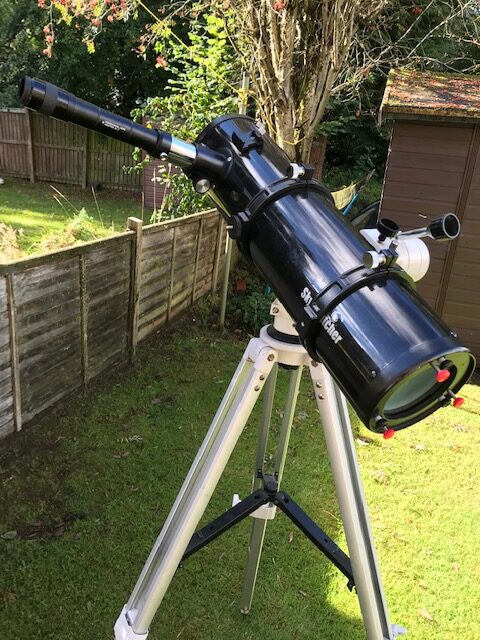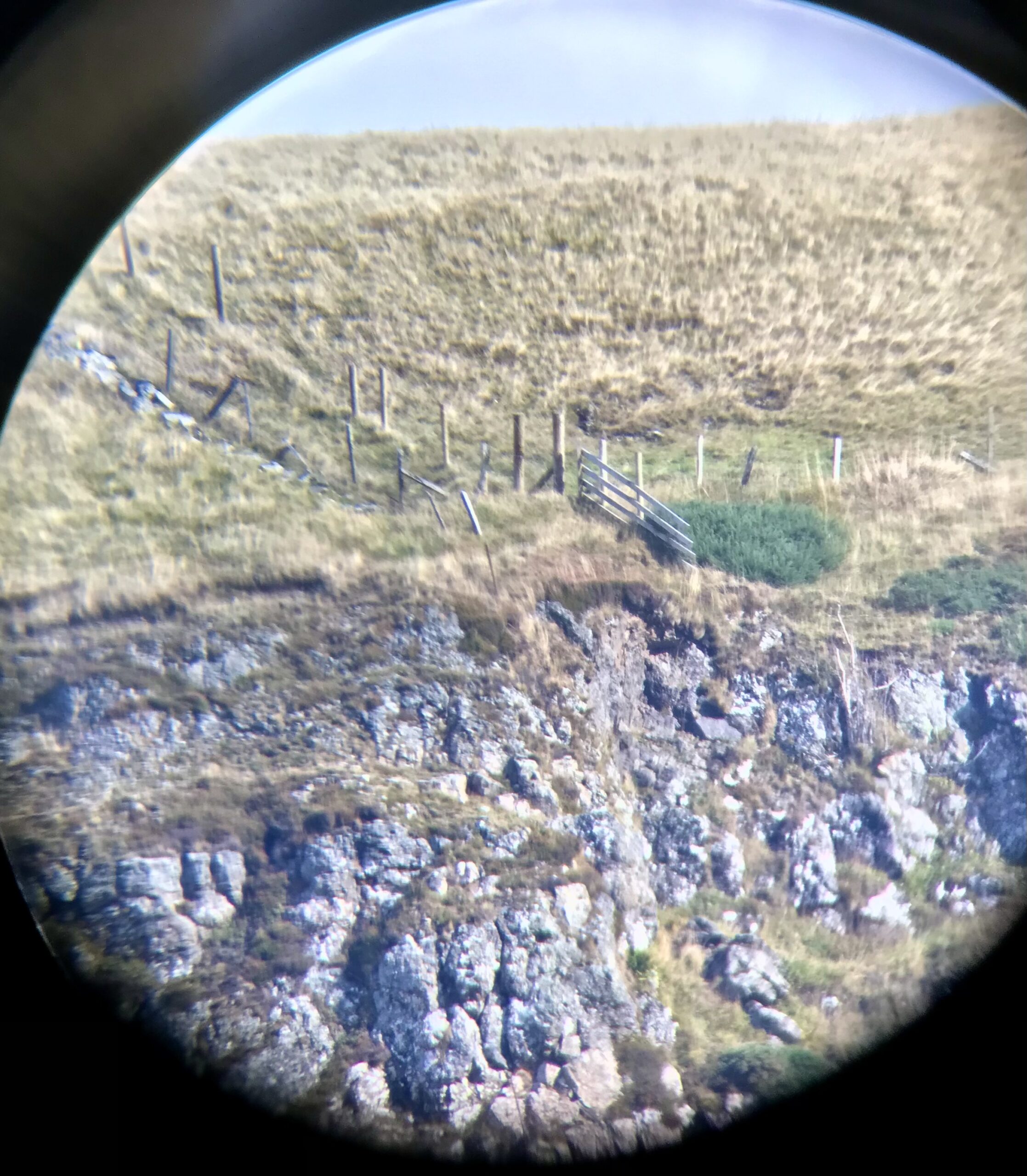
Plotina: the author’s modified 130mm f/5 Newtonian reflector, with a Vixen Erecting Adaptor and two simple Plossl eyepieces used in the investigation.
A Work Commenced October 3 2021
In this blog, I’ll be demonstrating the potential of a small Newtonian reflector operating in spotting ‘scope mode. This follows on from a previous blog I conducted to find a suitable optical device that would give fully erected and correct left-right orientation, just like a conventional spotting scope.
First, a few words of introduction about the telescope. It’s a 130mm f/5 SkyWatcher Newtonian reflector, so has a focal length of 650mm. Because of its open-tube design, the instrument is surprisingly light; just 3.8 kilos(8.4 pounds) and 4.1 kg (9 pounds) with the mounting bracket attached. It acclimates fully in 30-40 minutes, even when taken from a warm indoors environment to the cold of a Winter’s day. But such thorough cooling is only necessary to coax the highest powers out of the instrument.
The instrument has mirrors treated with state-of-the-art Hilux coatings(applied by Orion Optics, UK), increasing its overall reflectivity to 97 per cent. The primary mirror is the original one supplied by SkyWatcher, while the secondary flat mirror was upgraded with an Orion Optics UK secondary, having a flatter surface and smaller semi-major diameter of 35mm. This provides a small 26.9 per cent central obstruction. This size of central obstruction is significantly smaller than a Maksutov or Schmidt Cassegrain (SCT) of the same aperture. Unlike the popular Maksutov, the 130mm Newtonian(aka Plotina), can deliver a significantly lower magnification. For example, using a 32mm Skywatcher Plossl, it delivers a power of just 20x and using another Plossl of focal length 10mm, the telescope provides an amplification of 65x. I used these two eyepieces to demonstrate the spotting scope potential of the Newtonian, as many conventional spotters provide magnifications in this range(20-65x), corresponding to exit pupils of 4.7 and 2mm, respectively.
The contrast transfer is provided by subtracting the aperture of the secondary from the primary(130-35 = 95mm), thus one can expect a degree of contrast equivalent to a 95mm apochromatic refractor. Its light gathering power and resolution(0.89″) are significantly higher than a 95mm refractor, however. This has been borne out in several years of observations of lunar, planetary, double star and deep sky observing. The reader will find several other blogs I have published on this instrument in the past by clicking on the ‘Telescopes’ link on the home page.
The Erecting Adapter: Purchased for £80, the Vixen erecting adapter is a rather long appendage but delivers an upright image with the correct left-right orientation, just like a conventional spotting ‘scope. The lenses in the adapter are fully multi-coated and truncates the field a little when employing longer focal length eyepieces. You simply insert the desired eyepiece into the adapter, focus the ‘scope, and you’re off to the races!

Plotina, with the erecting adapter attached.
The instrument was used in broad daylight outside on a cool, breezy autumnal day, between heavy rain showers. It was mounted on a simple non motorised alt-azimuth(Vixen Porta II). The instrument is equipped with Bob’s Knobs screws for quick and easy collimation using a Hotech laser collimator. Alignment of the optics takes just a few seconds to get precise alignment of the secondary and primary mirrors. All of the images were taken simply by pointing my Iphone 7 into the eyepiece and taking single images. The pictures presented here are the highest resolution I can load onto this website( ~200-750KB), so are not the highest quality that I can potentially show. All the images are completely unmodified, apart from cropping. All distances quoted were measured with a laser range finder, and all the images were taken on the same breezy afternoon of October 3 2021.
Results:
Image 1: Shows a TV satellite dish at a power of 20x located at distance of 27 yards:

Image 2 shows some autumn leaves at 20x and located at a distance of 18.9 yards

Image 3 shows the branches of a tree at 20x located 43.1 yards from the scope:

Image 4 shows a hill top located at about 2 km distance at 65x

Discussion:
I am very encouraged by the results I obtained this afternoon. Irrespective of the scepticism of arm chair theorists, the images speak for themselves! The instrument provides very nice, high contrast and colour pure renditions of a variety of targets. Chromatic aberration is particularly well controlled, as expected, given that the Newtonian is a truly apochromatic optical system, though some secondary spectrum is introduced by the eyepieces chosen. In addition, higher quality eyepieces will give better off-axis performance, and because those oculars are inter-changeable, a greater range of magnifications can be explored. Visually, the images are considerably better when examined with the naked eye. The reader will note that these magnifications are somewhat pedestrian for such a large telescope. Visually, much higher magnifications can be utilised profitably. And although the formidable resolving power of the instrument is clearly in evidence, the images could be improved further by employing a higher quality phone camera. What’s more, the images could also be processed lightly to bring out even more details.
The set up, though admittedly bulky by conventional spotting scope standards, could quite easily be erected in the field or, better still, in a hide, where it could be used to gather video footage or still images with the right equipment. Observing from indoors, through a clean window is also a distinct possibility, especially at lower powers. The instrument is not weatherproof however, owing to its open-tube design, so may be prone to dewing up but a small, battery-operated fan would extend its longevity in field use.
I believe this provides a very cost effective way(the entire apparatus set me back just a few hundred pounds) of obtaining high quality images compared with a high-end apochromatic spotter.
Food for thought!
Thanks for reading!
Dr Neil English spent most of his adult life testing and observing through telescopes of all varieties and genres. He now enjoys a new lease of life exploring the terrestrial realm during daylight hours.
De Fideli.